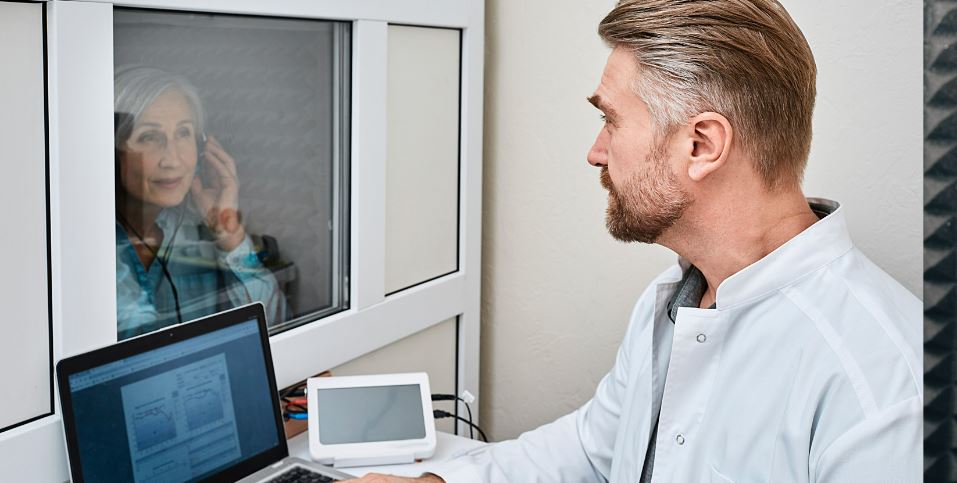(Author’s note) I write this as a true believer and not for any financial gain. Neither Etymōtic Research nor any very tall bald engineer with a bushy moustache has offered remuneration for this paean to QuickSIN. It’s all me, folks. I’ve done drunk the KoolAid.
–Paul Teie, MS
First, a tiny bit of history is in order.
- The standard audiometric test battery (Pure-tone air and bone conduction, Speech Reception Threshold, Word Recognition, and Tympanometry) has been around in its current form for nearly 50 years. The final new component clicked into place when James Jerger introduced the current tympanogram classification system in 1970.
- Directional microphones have been around about as long, introduced in 1969. They did not gain much traction until the advent of digital hearing aids and the explosion in their use began in the early 2000s. By 2005 nearly 50% of hearing aids dispensed had directional microphones, and by today virtually all include them.
- Speech-in-noise testing has been around the edges of audiology for many years. In 2004 Mead Killion and his colleagues introduced a very simple and practical way to quantify the ability of a patient to understand speech in noise – QuickSIN.
Hearing aids employ directional microphones to assist our patients to hear better in noise (said Obvious Man). Hence, it stands to reason that it would be a good idea for hearing professionals to be able to quantify our patient’s ability to understand speech in noise.
Still, QuickSIN (nor any other speech-in-noise test) has yet to break through to become an equal partner with the venerable five components listed above. It is time for that to change!
QuickSIN is a quick (5 minutes max) and easy test that allows the hearing care provider to quantify their patients’ ability to understand speech in noise.
While it is beyond the scope of this little essay to delve into the details of administration and scoring (suffice to say, it is not difficult), I will explain why I think it is an important test to perform, what it can and cannot do, and how to explain it to your patients. But a brief description of the test might be helpful.
QuickSIN is presented under earphones/inserts (it can be done in soundfield as well, though that kind of messes with the quick and easy thing). A female speaker recites sentences – each containing five target words – while 3-person babble takes place in the background. Each QuickSIN set contains six sentences. With each sentence, the intensity of the babble increases (preset, no fiddling required) by 5 dB. The first sentence is presented at +25 dB signal-to-noise-ratio and the last is at 0 dB SNR. The result is expressed in signal-to-noise-ratio loss (SNR loss – more about that later) and the lower the SNR loss, the better the patients speech understanding in noise.

To Whom Should the QuickSIN be Administered?
QSIN (I got tired of typing all those letters) should be a routine part of any hearing aid evaluation. A better question would be, to whom should this test not be administered?
My rule of thumb is: the likelihood-of-undue-anxiety-or-frustration test. Some patients have such poor word recognition ability, severe hearing loss, or cognitive challenges that this test could be a frustrating experience. It may be a good idea not to expose them to undue stress. I offer no specific criteria; let common sense and clinical experience be your guide.
Four Reasons to do QuickSIN
While QSIN is a terrific counseling tool, I do not consider it a sales tool (there are those that do). Most patients already realize they have trouble hearing speech in noise. This puts a number on it.
Another thing QSIN is not is a verification tool. For directional microphones to perform there must be spatial separation between speech and noise. QSIN is set up monaurally with speech and noise are originating from the same source. Deep in the nether regions of the QSIN CD can be found tracks where the speech and babble are separated into two channels. Using those tracks, verification can be accomplished with speakers positioned at 0˚ and 180˚ azimuth. Manual control of signal and noise intensities is required. To a geek like me, that kind of sounds like fun. But it may be more trouble than some would be willing to bother with.
So then, what are the advantages of QSIN.
- Ubiquity of directional microphones – As mentioned above, since most hearing aids dispensed today include directional microphones, understanding how much difficulty our patients endure understanding speech in noise can be useful. To me it is as important as understanding their thresholds and tolerance for loud sounds in setting gain and compression characteristics. Very good SNR loss scores may not encourage us to disable our patients’ directional microphones (tho, in the name of spatial awareness, doing so may not be such a bad idea for someone with a very low SNR loss), but still we should know how much or little they need them.
- Face Validity – I can’t recall the last time a patient came to me complaining they were having trouble hearing beeps or understanding single words in isolation. Just hasn’t happened. And we have all been challenged by the occasional patient asking what those beeps are all about. But every day your patient is talking to someone while others are talking at the same time. They experience this “test” every day in real life. Patients often respond to this test by saying it is the first time they have had a hearing test that evaluates a problem they have.
- Competitive advantage – QSIN can be one of the things that sets you apart from your competition. There is a very good chance that “the guy down the street” is not using this test. You can be the innovator and trail blazer that every patient hopes their hearing care provider will be.
- Reduce returns – I have left the best for last.
Here is a scenario I would bet many of you have encountered:
A new patient tells me, right off the bat, “You and I can be talking one-on-one like this and doing just fine, and all that has to happen is a couple people start talking outside the door, and I am completely in the weeds!” As a competent and compassionate hearing professional, my response is, “We’re going to get you set up with directional microphones and [famous last words] you’re gonna do great!!!!” Lo and behold after fitting and adjusting and fiddling and tweaking for the next month, they don’t do great. What the heck? They finally return with bag in hand, and I wonder what went wrong.
If I had done QSIN I may have seen an SNR loss of 20. This patient is unlikely to find much benefit in directional microphones. I promised something I couldn’t deliver – with d mics, anyway.
They would do much better with an FM system or streaming remote microphone to really juice up their signal-to-noise-ratio.
What Does SNR Loss Mean?
The table below describes the interpretation of SNR loss:
SNR loss is defined as the signal-to-noise ratio at which the patient understood 50% of the target words. That definition is fine between you and me but is pretty much meaningless to most patients. I have found that for most patients the results are self-evident and they require no explanation. If a patient asks, this is how I describe it (with editorial notes in parentheses):
“QuickSIN shows your SNR loss is 10 dB. Imagine you are at a cocktail party or some similar gathering. The noise level in that kind of environment is about 75 deciBels. (Your patient may not know from 75 dB, but they have likely been in that kind of environment and this provides a practical reference.) So in order for you to understand half of what the person to whom you are talking is saying (not strictly accurate, but it gets the point across) he or she will have to speak 10 deciBels louder than the noise or 85 deciBels. (they will realize the other person will have to be pretty much hollering to be that loud). But your hearing aids will have directional microphones, reducing sounds from the side and the rear so that you will be able to (benefit language – we will talk about that in a future article) hear your communication partner clearly, in spite of the noise in the room.”
So go forth and QuickSIN. It’s about time you shook up your test battery, and it’s good for you too!
 Paul U. Teie, MS, has been an audiologist since 1991. He has spent much of his career in direct clinical care but has filled other roles in the hearing care industry as sales representative of a special instrument dealer and a hearing instrument manufacturer. Since 2007 he has provided sales and clinical training for large hearing care networks and currently trains for HearUSA/HearCanada.
Paul U. Teie, MS, has been an audiologist since 1991. He has spent much of his career in direct clinical care but has filled other roles in the hearing care industry as sales representative of a special instrument dealer and a hearing instrument manufacturer. Since 2007 he has provided sales and clinical training for large hearing care networks and currently trains for HearUSA/HearCanada.







